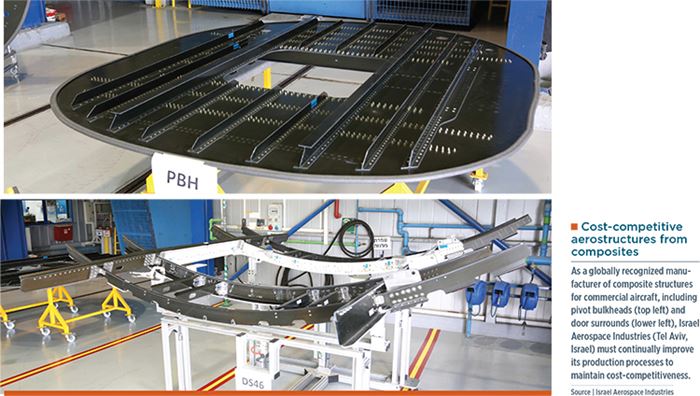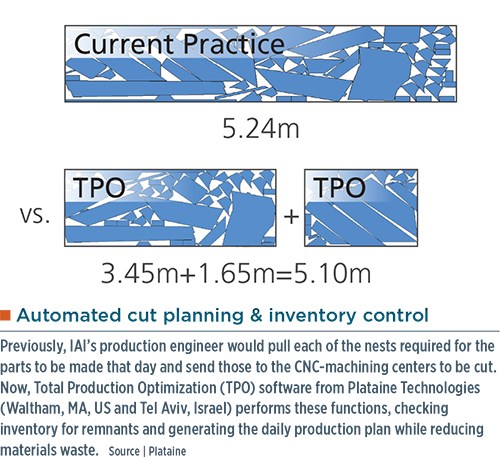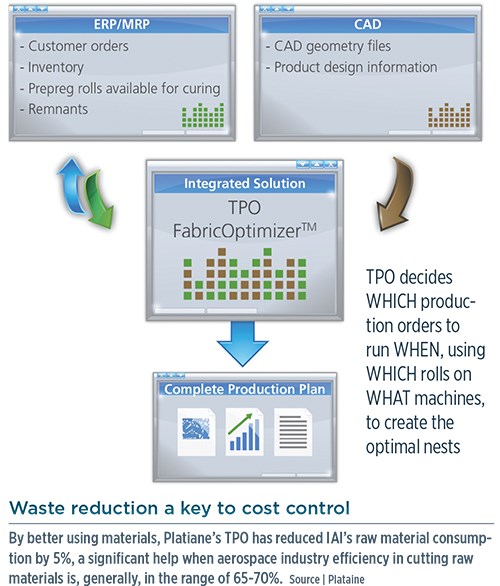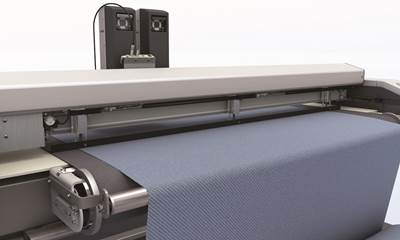Optimizing composite aerostructures production
Israel Aerospace Industries ramps production while reducing costs and improving quality thanks to integrated optimization software.
A globally recognized military and commercial aerospace and defense company, Israel Aerospace Industries (IAI, Tel Aviv, Israel) is simultaneously a Tier 2 supplier (e.g., to Alenia, for the Boeing 787 program) and a Tier 1 supplier to OEMs, such as Lockheed Martin, Boeing and Gulfstream. For the Boeing 787 program, IAI’s Commercial Aircraft, Group Aero-Assemblies Div. produces a variety of carbon and glass fiber prepreg aerostructures.
Two years ago, as IAI prepared for Boeing’s planned production ramp-up to 10 787 aircraft per month, the company was looking for ways to maintain favorable financial performance during an economic downturn and increase its competitive position in the global aerostructures market. Increasing output on the 787 program while reducing cost offered an excellent opportunity, but would also present a challenge.
“We looked everywhere for how to cut costs, and then we saw our waste and raw materials,” recalls Avishay Hod, composite deputy director for IAI’s Group Aero Assemblies Div. “We buy very expensive raw materials and then cut these to form composite aircraft structures, so there is a lot of waste.”
Already aware of Plataine Technologies’ (Waltham, MA, US and Tel Aviv, Israel) composite cut-planning optimization software (see “Automated cutting accelerates,” under "Editor's Picks" at top right), IAI sought more than optimized nesting. Plataine suggested its Total Production Optimization (TPO) software, and the two companies began implementing a system that would, by early 2014, not only cut raw material consumption by 5% but also automate daily production plans for materials and cutting, greatly reducing manual tasks and improving materials utilization. Automation has freed up resources and reduced the risk of errors. That, in turn, has generated cost savings in terms of improved quality control.
Daily work plan in one click
On any given day, IAI Aero Assemblies makes multiple parts. Its CNC cutting machines require dozens of nests to process a wide inventory of materials. “Mostly, we are cutting glass and carbon fiber prepregs,” says Hod, “but each part can use three or four different types.” Like most other aerospace manufacturers, IAI already had in place manufacturing resource planning (MRP) software and computer aided design (CAD)/engineering programs, such as CATIA (Dassault Systèmes, Velizy-Villacoublay, France). “But there was nothing that bridged the gap between these systems,” says Plataine president Avner Ben-Bassat, noting for example, “MRP would output the production schedule and materials inventory for each day, but the production design — specifically, what materials, shapes, tools, autoclaves and ovens were needed — was detailed in the engineering platform.” Therefore, many manual operations were still required. “Production engineers would take the MRP printout and then go to the engineering office to pull each part’s nest from a library,” Hod recalls.
Ben-Bassat describes this library as static vs. dynamic: “There is typically one nest per kit and one or more kits per aerostructure.” Thus, the production engineer would pull each of the nests required for that day’s parts and send them to the CNC machining centers to be cut. “So these operations were tied to inventory and production schedule, but they were not integrated or optimized.”
“What is good with TPO is that the daily work plan is now generated from the MRP through TPO with one click,” says Hod. TPO develops the plan, produces the optimized nest, chooses the materials and provides the optimized nest files for the operator. “All of the tracking the operator used to do is now done in a few minutes,” Hod explains. “The operator’s tasks are now reduced to getting the rolls of materials and starting the cutting machine. This reduces not only manual labor but also opportunities for error. It increases our efficiency and our process control, which improves quality.”
Reduced waste, improved efficiency
When asked about the 5% savings in raw materials, Hod admits this does not sound like much, “but when you use hundreds of yards per day of hundreds of raw materials, it adds up.” He also notes that in aerospace, the typical efficiency in cutting raw materials is usually only 65-70% — 30% is waste. “So being able to reduce this also adds to the bottom line.”
IAI has many material rolls of different lengths in cold storage. “Before, we didn’t know when to best use the remnants,” says Hod. “Would we have enough to make all of the parts for that run or that day?” Now, TPO does that analysis. “Before, looking at which rolls were closest to their expiration date and out-time limits was all done manually,” says Hod. Now it is automated.
One final point also has an impact: “I am gaining material that I previously did not use but I am also freeing up operator and engineering resources.” Hod explains, “When you have to increase your production rate, you have to spend more operator and engineering time because you are increasing the time machines are in use and the coordination of materials into products. But if you don’t double your operator and engineering hours because of something like TPO, then this allows you to increase your production rate without increasing your overhead.”
He notes one additional value due to TPO’s integration in both the inventory and MRP systems: “I can make better decisions about how much materials to buy and when. This sometimes saves more money than the 5% raw materials reduction.”
Implementation
IAI fully understood that integrating TPO into its production would require training. Ben-Bassat notes the process was made easier because “continuous improvement is in IAI’s DNA, so there was no challenge in getting everyone’s buy in.” That said, Plataine’s experienced integration team still had to answer a lot of questions and make sure IAI’s needs would be met. “We had to make a lot of adjustments,” says Ben-Bassat. “We then began testing the configuration.” The team started with one nest on one product and performed validation tests to make sure IAI’s team got the results it wanted. “Every day we would add more products, but we kept to static nests until week two.” Plataine then began combining nests and adding products and functions until TPO was fully implemented across all parts in production. “It’s no different from any enterprise-level software implementation,” says Ben-Bassat, “you don’t want to just flip the switch overnight. It took three to four months in all.”
Staying competitive
IAI has not yet incorporated the RFID tracking available with TPO, but Hod says the company might do so in the future. “We are always looking to improve,” he observes, explaining that all suppliers in the commercial aircraft industry are under pressure to reduce the price of their products. “Although the parts are very expensive, we are always looking at how to do this to meet our customers’ needs,” says Hod. “We must remain competitive.”
Related Content
Plant tour: Albany Engineered Composites, Rochester, N.H., U.S.
Efficient, high-quality, well-controlled composites manufacturing at volume is the mantra for this 3D weaving specialist.
Read MorePEEK vs. PEKK vs. PAEK and continuous compression molding
Suppliers of thermoplastics and carbon fiber chime in regarding PEEK vs. PEKK, and now PAEK, as well as in-situ consolidation — the supply chain for thermoplastic tape composites continues to evolve.
Read MoreThe lessons behind OceanGate
Carbon fiber composites faced much criticism in the wake of the OceanGate submersible accident. CW’s publisher Jeff Sloan explains that it’s not that simple.
Read MoreCombining multifunctional thermoplastic composites, additive manufacturing for next-gen airframe structures
The DOMMINIO project combines AFP with 3D printed gyroid cores, embedded SHM sensors and smart materials for induction-driven disassembly of parts at end of life.
Read MoreRead Next
Automated cutting accelerates
Software/hardware advances and peripheral equipment make flatbed cutters essential to automated production scenarios.
Read MoreVIDEO: High-volume processing for fiberglass components
Cannon Ergos, a company specializing in high-ton presses and equipment for composites fabrication and plastics processing, displayed automotive and industrial components at CAMX 2024.
Read MorePlant tour: Daher Shap’in TechCenter and composites production plant, Saint-Aignan-de-Grandlieu, France
Co-located R&D and production advance OOA thermosets, thermoplastics, welding, recycling and digital technologies for faster processing and certification of lighter, more sustainable composites.
Read More

























